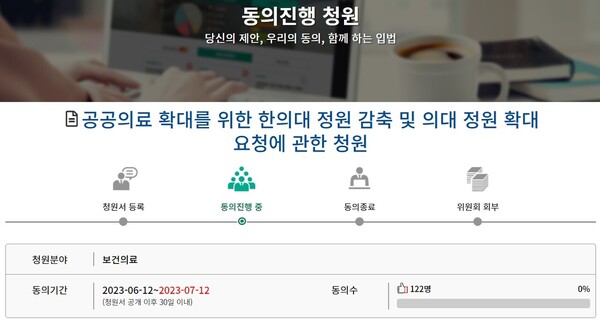
As the government and the medical community start discussions to expand the medical school enrollment quota in earnest, calls are mounting for reducing the number of oriental medicines practitioners to increase that of physicians.
Those who make such claims say it is inevitable to put more medical manpower into solving the problems of “emergency room touring” and filling the medical void in vulnerable areas due to the lack of essential medical personnel, calling for using oriental doctors’ quota to provide scarce essential medical care.
Recently, a petition to reduce the enrollment quota at oriental medicine schools and increase that in medical schools to expand public healthcare was posted as a consent agenda on a national petition board. The petition was posted on Monday last week, and as of Tuesday, eight days later, 122 people have agreed to it.
Citing data from Statistics Korea, the petitioner argued that while the average number of doctors per 1,000 people in the Organization for Economic Cooperation and Development (OECD) member nations is 3.4, Korea had only 2.3 doctors, including oriental medicine doctors, per 1,000 people. The number of hospital beds per 1,000 people was also insufficient, with just 12.4.
The number of oriental medicine clinics nationwide totaled 14,526 in 2021, almost half of the western neighborhood clinics (33,912). However, according to the petitioner, the share of reimbursement made by the National Health Insurance Service showed a gap of more than seven times, with 2.7 percent to 20.1 percent.
“In rural areas, it is challenging to secure doctors. Even in urban centers, emergency patients die after spending hours in ambulances due to deteriorating emergency medical infrastructure,” the petitioner said. “There are sufficient beds for patients but few doctors to treat these patients.”
The petitioner pointed out that the number of oriental medicine clinics is almost half of the neighborhood clinics. Still, the reimbursement gap between them is over seven times.
“This means there is a problem with the supply ratios of doctors and traditional Korean medicine practitioners. In other words, there are too few doctors and too many oriental medicine practitioners,” the petitioner said. “Therefore, I propose to reduce enrollment quota at oriental medicine schools and increase that in medical schools to expand public and essential healthcare.”
Related articles
- Expert urges increase in medical students to address essential care crisis
- Bumpy road ahead for planned increase of medical student quota
- Government set to increase medical school enrollment quota from 3,058
- ‘Ministry opens up all possibilities in discussing medical school quota increase’
- Top pediatric cardiologist laments politics’ ill effects on medical sector
- Government and ruling party press medical community to increase physicians
- Health minister reveals will to reduce oriental doctors to increase physicians
- It’s hard to secure local doctors with forced placement, Japanese expert says
- Health minister hints medical school enrollment quota could increase soon

